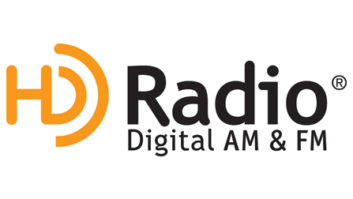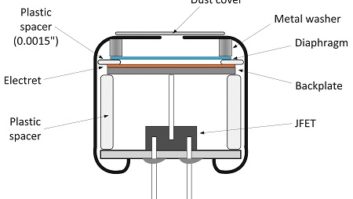One official shoe of the IBOC power issue has dropped, with a formal request submitted in June to the FCC by a consortium of broadcasters and manufacturers. Now the industry faces questions about whether the approval shoe should drop — and what might happen if it does.
The idea of allowing FMs to raise digital power on a voluntary basis by up to 10 dB — from the current –20 dB below analog carrier to –10 dB — is touchy.
(click thumbnail)Cautioning against a rush to approve a power hike, Bert Goldman points to potential digital second-adjacent interference, for example as shown here to analog KTYS in Dallas.A power increase involves operational transmission costs. Critics also raise questions about increased interference that may result from higher IBOC power levels.
Some broadcast engineers involved in the digital rollout are asking if other ways of extending a station’s digital coverage to match analog can be explored without placing additional cost burdens on stations at a time when managers are coping with soft revenue and steeper power costs.
Proponents say it’s critical to allow higher digital power, to improve building penetration to home and office IBOC receivers as well as robustness of the digital signal in time for the introduction of HD-R portables. Ibiquity Digital predicts HD-R portables will be available to consumers at year-end or in the first quarter of next year.
The consortium pushing for the increase says tests demonstrate it would help improve radio’s digital FM performance “with minimal risk of harmful interference to existing analog service.”
‘Largely replicate’
“Whatever is done needs to be done in a timely manner,” said Milford Smith, vice president of radio engineering of Greater Media.
“If [the rollout] goes on with no corrective action, I think we’ve got some real issues with the continued viability of HD Radio. People have a certain expectation. HD Radio needs to largely replicate the FM [analog] service if it’s to be logical.”
Smith was careful to say that he was stating his personal view on the power issue. Greater Media is one of the early adopters of IBOC and one of the broadcast groups supporting a power increase. He also chairs the National Radio Systems Committee.
He is not alone in his opinion; other sources close to the issue said they believe the next couple of years are telling for the future of IBOC.
The group of 18 organizations asked the FCC in June to approve the power boost, and they would like the FCC to act quickly. While Smith would prefer to see the increase approved by the time HD-R portables hit the market, he said if the issue is resolved within a year or so, that would still help stations that have converted to digital.
In Support of an IncreaseA group of 18 organizations asked the FCC in June expeditiously to approve the power boost, the equivalent of an increase from 1 percent to 10 percent of a station’s authorized analog power.
Those requesting the increase include broadcast owners, transmission manufacturers and Ibiquity Digital. The NAB and the HD Digital Radio Alliance filed public comments at the commission supporting the request.
Equipment manufacturers on the filing include Broadcast Electronics, Continental, Harris and Nautel. Broadcasters include American Public Media, Backyard Broadcasting, Beasley, Black Crow Media Group, Bonneville, CBS, Clear Channel, Commonwealth Broadcasting, Commonwealth Public Broadcasting, Cox, Emmis, Entercom, Greater Media, Journal, Lincoln Financial Media, NRG Media, Radio One and WNYC.
A power boost was a major topic among technical managers during the spring NAB Show and is likely to be so again at the fall NAB Radio Show.
Test results submitted to the commission by CBS, Ibiquity, Greater Media and Clear Channel compared performance on a total of seven stations with digital power at –20 dB and at –10 dB to determine the extent of the digital coverage improvement.
Class B FMs in Detroit, Los Angeles and New York experienced an average increase of 24 percent in service radius and an average 65 percent gain in coverage area, according to the group, while Class As saw an average increase of 30 percent in service radius with an average 67 percent gain in coverage area.
“(T)he increased power significantly reduced the area within each station’s core coverage area in which the digital signal could not be received,” the group states in the June 10 FCC filing (Docket 99-325).
The consortium says its test results demonstrate that the power increase would help improve radio’s digital FM performance “with minimal risk of harmful interference to existing analog service.”
The tests included an analysis of super-powered FMs and short-spaced stations. Testing inside the protected contour area of stations highlighted one area of potential concern: severely short-spaced Class Bs may be at increased risk of receiving interference from the digital signal. Outside the protected contour, Super Bs operating at the higher digital power level were shown to have the potential to impact first-adjacent Class Bs, according to NAB, which supports the consortium’s recommendations on limits on the digital power for Super Bs.
Also included in the submission was a test by CBS on HD-R receiver penetration using KROQ(FM), Los Angeles at the higher FM IBOC power level (RW May 21, page 8).
—Leslie StimsonSmith also noted that not every station would immediately raise its digital power if the agency approved a boost. Costs and other implementation issues determine that timing.
Mike Troje, sales manager for Continental Electronics, one of the manufacturers supporting the power increase, agrees.
“The reality is anyone in a major market with a TPO of 20 kW or greater will need to modify their transmission system” in order to implement the power increase up to the full 10 dB, he said.
Marty Hadfield, a broadcast consulting engineer and former vice president of engineering for Entercom, said some stations may have the headroom in their digital transmitters now to implement an increase of perhaps 1 to 6 dB; however he doubts “that many can simply go out to their site now and have it be fully functional.”
A station that leases rather than owns its tower space could face rent increases if it wanted to increase digital power, especially if a tower already is overloaded and the station can’t modify the antenna to handle the HD-R signal separately, he said.
Higher power levels have a ripple effect, said Hadfield, in the necessary extra footage for additional transmission equipment, more air conditioning and higher electricity costs.
A typical FM was paying approximately $150,000 to convert its plant before the recent introduction of the embedded exporter. That figure is more like $130,000 to $140,000, Troje said.
Troje concurs that the timing of a power increase approval is crucial. “The ball is rolling now. As a manufacturer, this has our attention. We have to be prepared to give somebody an adequate solution whenever or however this gets resolved.”
Yet getting the commission’s attention on the issue may be difficult. Chairman Kevin Martin’s time leading the agency could be winding down with a new administration coming in; the agency, like other organizations, tends to get less done in the summer season; and come the fall, commissioners and the rest of the country can be expected to turn their focus toward the presidential race. Politics does make itself felt in the halls of the Portals.
John Garziglia of the law firm Womble Carlyle Sandridge & Rice said, “Nothing happens at the commission unless someone [in Congress] is behind it.”
Proponents say they believe the power hike request has sufficient political backing to pass, although certainly the big broadcast groups, in addition to the NAB, will need to lobby for it.
First and second
Not all broadcast groups with stations airing HD Radio believe this is the time to push for a power boost.
Bert Goldman, vice president of engineering for Independence Media and a member of the NRSC, questions whether enough studies have been done and wonders if there is another way to accomplish an increase in digital coverage.
Tests conducted by the backers of the power increase focused on possible interference to the host analog and first-adjacent digital neighbors, in the belief that these would be the most likely to suffer interference.
Goldman believes tests for possible interference for second-adjacent channels should have been completed before the request was filed.
So-called rim-shot stations will receive increased analog interference from their neighboring second-adjacent, in-town digital neighbors if the digital power is increased, he said, using a coverage map of Dallas station KTYS(FM) as an example.
“Before we go rushing into something, we need to evaluate the impact. So far everyone I’ve turned my map over to have gone into hiding or said it’s conservative,” said Goldman.
He said he’s not trying to stop the HD Radio rollout and that indeed he is a proponent of the technology.
“I would like nothing more than to have someone tell me that I’m all wrong and why. Unfortunately nobody has yet done that, and if my suspicions are correct, then substantial harm could be inflicted upon hundreds of FM analog stations that count on their fringe 60 dBu signals.”
Hadfield agreed that more questions need to be asked, especially of receiver and chip manufacturers.
“Why is the onus for the success of the power level increase on the broadcasters? Why not on the receiver manufacturers? I have not heard that receiver manufacturers have come to the game with improved sensitivity,” he said, believing radio makers are keeping their costs down to keep prices low for consumers.
HD Radios that are much less expensive have lower sensitivity and are less able to pull in the IBOC signals, Hadfield said.
Of the receiver question, Smith said, “Based on what I know, there is not a lot of improvement possible on the receiver side to improve IBOC reception, especially for receivers that have to sell for a competitive price. What actually happens in many cases is that the IBOC signal becomes reduced to a point where it is actually below the noise floor of the FM band and would not be recoverable by any conventional receiver.”
He deems the current crop of HD-R receivers “reasonably decent” in terms of sensitivity.
The power increase tests were not conducted under the auspices of the NRSC; that standards body wasn’t asked to consider the issue by NAB or CEA, its sponsoring organizations, Smith said.
The group has discussed whether to take up the issue and was waiting to see results of NPR Labs’ separate testing. Those findings would be released by the Corporation for Public Broadcasting, which funded the NPR tests. Sources said those could be released in July.
NPR found that an IBOC power increase would benefit home listening most but that the resulting increased interference likely would hurt analog mobile coverage (RW July 2, page 22).
Members of the testing and standards community at the NRSC and NPR Labs have been discussing whether further work can be done, Smith said, describing the power increase request as the start of a process.
“Initially, there’s going to be people with different thoughts about where we’re going. Part of the reason (the consortium) wanted to get this out there is to let people weigh in and get this moving forward.
“When all is said and done, there’s an issue here that needs to be resolved, and in a timely fashion.”





